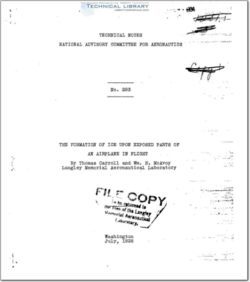naca-tn-293

- Version
- 157 Downloads
- 672.86 KB File Size
- 1 File Count
- April 23, 2016 Create Date
- April 23, 2016 Last Updated
National Advisory Committee for Aeronautics, Technical Notes - The Formation of Ice Upon Exposed Parts of an Airplane in Flight

The formation of ice upon the Wings and other exposed parts
of an airplane in flight has presented a hazard which has long
been appreciated. Experiences which have been encountered dur—
ing the last year have focused the attention of the aeronautical
world upon it and have brought forward a demand for more defit_
nite knowledge as to the character, the causes, and the POSSiPl9ml—
means of prevention of this hazard.
The National Advisory Committee for Aeronautics, at the
request of the Army and Havy, is coordinating and gathering all
the information in regard to actual accidental experiences and
further, has with some success, sought and examined the phenohe—
na experimentally.
Information which has been obtained from a large number_of
pilots who-have encountered this ice formation identifies the '
conditions as follows: A condition of high humidity, usually
heavy fog which, more often in the form of clouds, either broken
cumulus clouds, strata formation, or a condition of actual rain,
must be encoUntered at a temperature not more than a degree or
two below the freezing point, 38°F. The formation of ice has
been reported by some at temperatures considerably below 32°F,
but these reports in view of a preponderance of evidence as well"
as definite experimental data, appear to be of a secondary condi—
tion which in formation and in consequence are considerably dif—
ferent from the condition encountered at, or near 33°.
These many reports which come in the greatest numbers from
air mail pilots who by the nature of their work are forced into
or through conditions similar to those described above, indicate
that the DH~4 airplane, either on account of its more extensive
use or possibly on account of a peculiar susceptibility to the
conditions, has encountered the phenomena more often. The_ele—
ment of greater susceptibility appears to be confirmed by the
first evidences of ice formation appearing upon round Wires with
which this airplane is equipped.
| File | Action |
|---|---|
| naca-tn-293 The Formation of Ice Upon Exposed Parts of an Airplane in Flight.pdf | Download |

Comment On This Post